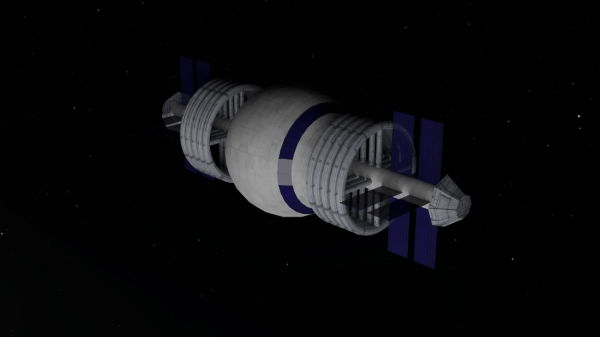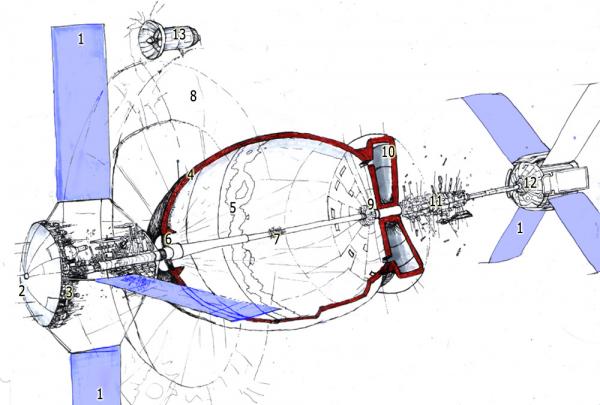BY LETTER
Bernal Sphere
Technology > Technology Type or Material > Drytech/Hylotech
Technology > Application > Infrastructure
Technology > Technology Levels > Middle Tech / Midtech
Technology > Application > Infrastructure
Technology > Technology Levels > Middle Tech / Midtech
Spherical Rotating Space Habitat | |
 Image from Copyright Lilly Harper | |
| Like many Bernal Spheres, this example is accompanied by several co-rotating agricultural rings | |
The spherical living accommodation in this version of the Bernal sphere is accompanied by several ring-shaped modules, illuminated by mirrors and dedicated to agriculture for food production. Sunlight is also directed into the sphere through windows near the axis. This concept would house 10,000 people in comfort.
In 196 AT the first Bernal Sphere, known as O'Neill One, was constructed using Lunar mining, manufacturing and launch infrastructure (much of which was teleoperated from Earth). The construction of this habitat was an important milestone, and even more important was the establishment of Lunar manufacturing infrastructure capable of launching manufactured parts into space.
 Image from Dagon |
| Key: | Sensei's Midgard Bernal Sphere (image by Dagon) |
|---|---|
| 1 | - Excess heat radiator fins; (does not rotate) |
| 2 | - Part of the habitat that faces the sun all the time - Radiation shielded area. (does not rotate) |
| 3 | - Industrial section and harbor (does not rotate) |
| 4 | - Hull section of the habitat proper; this also includes a thick layer of radiation absorbing material, mostly pure iron or titanium. (rotates) |
| 5 | - The world river (rotates with the habitat) |
| 6 | - The illumination windows. All sunlight which is collection by means of section (8) is converged through the windows and evenly scattered throughout the habitat according to need. Note that the air temperature near these windows is very high; it's a focal point. (rotates) |
| 7 | - The axis runs from the middle of (2), thoughout the center of (3) and midway through (6). This axis has an outer shell which rotates and a middle axis which doesn't rotate. Through the entirety of the axis runs a monorail system for passengers and cargo. |
| 8 | - Reflective material -foil essentially . This material rotates, but only to keep it stabilized in it's given tensile shape. Then it reflects the light inward. 'Behind' (3) there is a focal point (6) where light gets reflected a second time, through the windows and into the habitat. Note that the mirrors are not full-spectrum; they reflect only the light which has use inside the habitat; the rest is reflected away from the habitat. A large part could also be 'harvested' by means of solar collectors. Why waste it if you got it? |
| 9 | - A low gravity to nearly freefall station for the (7) axial monorail. |
| 10 | - Canyon - originally a 'hub' or 'donut' habitat that got integrated/assimilated into the current structure. There is open-air contact between the main habitat body and the hub. The hub is not illuminated very brightly, only through a number of 'slits', some stray light beams of light from (6) entering Canyon 'horizontally'. |
| 11 | - Harbor for yachts and pleasure craft |
| 12 | - Section for the A.I., robotics and lifeforms that don't like artificial gravity. Does not rotate. |
| 13 | - Agricultural hub. The entire habitat structure is surrounded by some 20-30 of these mini-habitats. They are not radiation shielded but with low gravity, high moisture atmosphere, low air-pressure they are well-suited to grow crops cheaply. The ring holding these agricultural hubs does not rotate; produce gets shuttled to the harbor or (possibly) there are elevators connecting the agricultural hubs with the industry sections. |
Several versions of the design have been built. Many modern versions are reinforced by diamondoid or buckyfibre, and can be up to a thousand kilometers in radius.
Image from Steve Bowers | |
| The inhabited portion of this Bernal Sphere is in the centre of the image; it is flanked by eight agricultural toruses, mirrors and photovoltaic panels | |
Related Articles
- Banks' Orbital
- Bishop Ring
- McKendree Cylinder
- O'Neill Cylinder
- Orbital (habitat)
- Orbital (political unit) - Text by M. Alan Kazlev
Originally, a nation state or city state based on habitats in orbit around Old Earth. Over the course of the Interplanetary Age the term came to be used for any such state in Solsys. By early First Federation times the term Orbital was used more broadly for any independent or semi-independent state based on a hab in orbit around a planet. - Rotating Space Habitats
- Stanford Torus
Appears in Topics
Development Notes
Text by Steve Bowers and Dagon
Initially published on 31 December 2007.
Initially published on 31 December 2007.
Additional Information
Image 'Bernal Sphere' copyright by Lilly Harper used with permission. Please contact her for conditions of re-use at https://beaconsinthedark.wordpress.com/.







